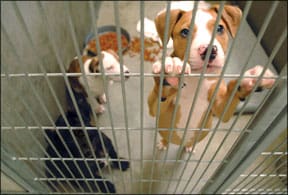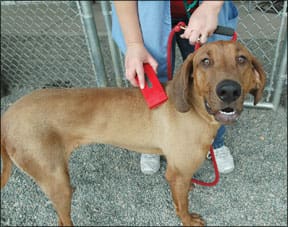Thinking of getting a new dog? Chances are you’re inundated with well-intentioned advice from every friend, family member, and canine professional you know about where to go and who to avoid in your quest to find your next canine pal. You may also feel the added burden of finding the right dog – one who will be as close to perfect as caninely possible. It’s an awesome challenge.
Many years ago, I was living on my own for the first time, and missed having a dog in my life. I went on a Collie search, and soon answered an ad in the paper for Marty’s Pride, a tri-color Rough Collie whose owner had gone off to college. Marty was near canine-perfect: the first dog I showed in AKC obedience competition (he earned his Companion Dog title in three trials with scores of 194.5, 196, and 197), and the first dog I ever owned who died of old age. He was also the last dog I deliberately went looking to adopt. Since then my selections have been much more serendipitous. My husband and I tend to adopt the dogs who find us, or we trip over them at the shelter and bring them home.

I realize that we’re the exception, not the rule. Most people make more deliberate decisions than we do about the kind of dog they want, and where to find him – or her. Those decisions, although deliberate, are not always wise. I’m constantly amazed by the number of clients in my behavior consultation practice who thought they were making well-educated, well-researched decisions about the acquisition of their new four-legged family member, and ended up with something vastly different from what they expected. So how do you make an educated, responsible decision about selecting your next dog?
Adoption options The advice you receive from friends and professionals can be conflicting and confusing. “Only buy from a responsible breeder.” “There’s no such thing as a responsible breeder; you should only adopt from a shelter.” “Omigosh you’re adopting from the shelter? Their dogs all have major behavior problems and kennel cough! You should adopt from a rescue group.” “Shelter or rescue? You don’t know what you’re getting. The only way to be sure of what you’re getting is to purchase a puppy from a breeder.” So who’s right and who’s wrong? They all are.
There are lots of different places you can go to get a dog. Some are better than others, and there are some you should never patronize. Here’s a guide to help you maximize your chance of getting the dog you want:
– Animal shelters. This is my personal first choice. I am painfully aware that there are good shelters and not-so-good ones (see “What You Should Know About Animal Shelters,” WDJ Jan 2009). If you live near a good one, your adoption process will be facilitated by knowledgeable and friendly adoption counselors who can help you make a good decision about your new family member.
In the good shelters, staff will have conducted behavioral assessments of the adoption dogs, which will provide you with useful information and help you determine if the dog might be a good match. If you live near a not-so-good shelter you have a choice – to adopt from that shelter, conducting your own impromptu assessment and risking diseases such as kennel cough and parvo that lurk in the corners of substandard facilities, or to travel a greater distance to adopt from a better quality shelter.
A really good shelter will give you a thorough and human-friendly vetting before they’ll agree to adopt one of their dogs to you. If they fall a little short on the customer-relations end of things, have patience and remember, it’s only because they really are concerned that their dogs go to lifelong loving homes. This caveat holds for any of the best placement programs – they will check you out carefully, and may sometimes be a little overzealous in those efforts.
Don’t rule out shelters if you’re looking for a particular breed or mix – many breeds show up in shelters with disturbing frequency. Ask your shelter if they have a waiting list or “wish list” for approved adopters who want to adopt a specified breed or type of dog. Then get your name on the list.
If you know what you’re looking for and what to watch out for, you can find great dogs in almost any bona fide shelter. If you lack experience or confidence in your dog selection talents, take along a knowledgeable friend or positive canine professional to help you make a good choice.
– Rescue groups. Another place to find the specific breed you want is a “breed rescue.” Like shelters, rescue groups can be good, bad, or ugly. Many breed-rescue groups are affiliated with breed clubs and tend to be responsible about healthcare, spaying and neutering, behavior assessment, and placement. Some even commit significant resources to medical treatment and behavior modification before placing their canine wards. But not all.
Non-affiliated rescue groups, especially those who rescue all breeds and mixes, or a wide variety of breeds and mixes, sometimes take on far more dogs than they can care for. Some end up more closely resembling hoarders than rescuers, neglecting the very dogs they claim to have saved. We absolutely encourage you to adopt from legitimate rescue groups, breed-affiliated or not. If you come across the non-legitimate variety in your travels, report them to the authorities.

You may be tempted to adopt one of the sad faces in a substandard rescue facility. If you do, know that you have a significantly greater likelihood of taking home a dog with physical, medical, and/or behavioral challenges.
– Responsible breeders. Yes, they do exist, although I know there are some who fancy themselves as “responsible” who wouldn’t fit my definition of the word. The list of qualities to look for in a breeder is long, but some of the most important are:
• Breeds mentally and physically healthy, genetically sound puppies.
• Socializes the puppies well to a variety of places and things as well as to people.
• Breeds no more puppies than she can find homes for.
• Requires spay/neuter for all puppies not destined for the show ring.
• Screens prospective puppy homes carefully and only sells to appropriate private-home buyers who can provide lifelong loving care.
• Allows the buyer to meet the mother of the puppies, and the father too, if he’s on the premises.
• Educates buyers about needs of dogs in general and the specific breed in particular. Will not sell a puppy to a person with unrealistic expectations of the breed.
• Provides follow-up to be sure pups are doing well and keeps in touch with owner for the life of the dog.
• Provides resources and support for owners who are having problems with their dogs.
• Takes back dogs who were sold any time, for any reason, for the life of the dog.
That’s a start; a much more comprehensive list can be found at wonderpuppy.net/1breeding.php. By the way, responsible breeders never:
• Sell puppies to pet stores.
• Sell sight unseen over the Internet. (They may have a website, but actual sales are personal, and the breeder should want to meet the buyer and have the buyer meet the puppy.)
• Meet you halfway and sell you the puppy out of the back of a truck.
• Prevent you from seeing the conditions under which the puppies were raised.
When I was still at the Marin Humane Society, in the early 1990s, we conducted a project to offer responsible breeders the opportunity to reclaim dogs of their breeding that had ended up at our shelter for any reason. Over a two-year period we received about 30 purebred dogs whose breeders we were able to identify and contact. Of those 30, only two came to reclaim their dogs, and at least one of those two was what many would probably have called a “backyard” breeder because she wasn’t involved in showing or competing with her dogs. That project was an eye-opener for us about the percentage of truly responsible breeders in the real world.

– Private adoptions. This covers a broad range of possibilities – including answering an ad in the paper like I did for my wonderful Collie; helping out a friend whose circumstances require her to give up her dog; taking in the canine companion of a friend or relative who has passed away; or falling for a “free to a good home” opportunity in front of a supermarket. You may even find you’ve been named as legal custodian for a friend’s dog in her will!
These can be great adoptions, or caveat emptor situations. If you can find the dog you’re looking for in the newspaper, you can skip the middleman (shelter or rescue group) and save the dog (and his human) a lot of stress. We’re talking adolescent to adult dogs here; responsible breeders never sell their pups through newspaper ads.
Look for key words in the ads that give you a clue as to why the dog is being given up. Phrases like “Needs ‘only dog’ home,” or “Not good with kids” tell you the dog has a behavior history that might be cause for concern. Ask the owner why he’s giving up the dog, and then weigh the trustworthiness of the answer in light of your own observations. In these days of foreclosures there are lots of good dogs going homeless for very legitimate reasons.
If you’re taking on the dog of a friend or family member, you probably already knew the dog before you agreed to take him. Be sure all parties are clear – in writing – about legal custody. Who will make decisions about the dog’s health and future, and who pays all the bills? What sort of visitation rights will the original owner have? If circumstances change, will the dog go back to the original owner or stay with you?
As always, use sound judgment when considering the adoption of a dog that someone else is giving up. Conduct your own behavior assessment to confirm the dog is someone you can love and live with for life, before making the commitment to bring her home.
– Found strays. One of my clients recently adopted a dog she found – or who found her. Maryann wasn’t really looking for a dog; she was perfectly happy with her Lhasapoo, Xena. But when an adolescent American Eskimo showed up on her doorstep she invited him in. She notified the shelter that he was with them and spent the next 30 days in fear that someone would claim him. Dexter is now a permanent part of the family.
In some locations, you have lots of opportunities to find and keep stray dogs. In other, more responsible communities, not so much. Bear in mind that most strays are not “professional” strays (as in “street dogs,” or feral), but rather dogs who got separated from an owner who cares about them, or perhaps dogs who were recently abandoned due to current economic conditions. In any case, if you find a stray you’re thinking of keeping, you must make an effort to find the owner, by leaving a “found dog” report with your local shelter, placing an ad in the paper, putting up posters, having him scanned for a microchip, and of course, calling any number provided on an ID tag and/or license on his collar.
Remember, you’re not morally obligated to keep a stray dog just because you found him. If you’re over your limit – legally, financially, or personally – or if he’s not a good fit for your family, you won’t be doing him any favors by trying to keep him.
– Petfinder. In a class by itself, Petfinder is an online clearinghouse of information (petfinder.com) about dogs (and other animals) of all breeds and mixes available for adoption from groups across the entire country. If you’re looking for a specific breed or mix, it’s almost guaranteed you can find it on Petfinder. Then you’re only faced with the challenge of a “sight unseen” adoption – not something I recommend. I suggest you use Petfinder to locate suitable dogs near you to consider for adoption, unless you’re willing to travel to meet them and bring them home if they meet your requirements.
– Pet stores? NEVER! The only positive about purchasing a puppy from a pet store is that you are essentially paying to rescue that doggie in the window – so it’s a good thing for that individual pup. I do have some clients who are completely happy with their pet store puppy purchase. But I have many more who love their dogs but are faced with problems common to pet store dogs, and regret not having made a wiser adoption choice. The risks related to buying pet store puppies so greatly outweigh the single good that we vehemently urge you to never even let the thought cross your mind.
For starters, when you purchase a pet store puppy, you are supporting the horrendous puppy mill industry. Every dollar you spend to rescue that beguiling face in the window goes to produce, market, and sell more puppies who are raised in substandard conditions by mothers who are nothing more than breeding machines, callously discarded when they can no longer produce. Don’t believe the store manager who reassures you that their puppies come from “responsible breeders.” No responsible breeder on earth sells puppies to pet stores. Not one.
Parents of pet store puppies are unlikely to have had any screening for hip dysplasia, eye problems, or any of the other myriad of genetic defects common to various dog breeds, so the chances are far greater that your pup will suffer from one or more of these debilitating defects in his lifetime. The puppies and their parents may have missed out on some important healthcare practices, such as routine worming and vaccinations. Worse, they are almost guaranteed to have missed out on the socialization experiences that are critical to normal social development. The sooner people stop buying pet store puppies, the sooner pet stores will stop selling them, and the sooner puppy mills and other irresponsible breeders will start going out of business.

The how of selection
You’ve determined the source from which you want to acquire your next dog, or at least identified which sources are the most likely candidates for you. The next question is how. How do you decide which dog is the right one? Let’s assume the family has come to agreement about breed, or at least variables like size and type. If you’re purchasing a pup from a responsible breeder, she will guide you in selecting the best pup for your circumstances and dog-owning goals. If you want to show or compete, she’ll have a good idea which of her pups are best suited for that. If you want a family companion, she’ll identify which pups in the litter are best suited for that role.
On the other hand, if she thinks your situation is totally unsuited for her breed – an active Border Collie or vocal Sheltie in a small apartment – she’ll tell you that too, and then decline to sell you a puppy. Take her advice to heart, rethink your adoption choice, and don’t just go get a puppy of the same breed from a less responsible source.
If you’re adopting from a good shelter or rescue, they will already have performed behavior assessments on your pool of prospective adoption choices, and will help you make an educated selection. If you’re doing a private adoption or looking to a group that doesn’t assess, you’ll want to do your own assessment to explore a few behaviors before you adopt.
If you are a novice dog owner, I recommend taking along a more knowledgeable a friend, or a behavior/training professional who offers pet selection services, to help you with your decision. If you are reasonably knowledgeable about dogs and dog behavior, you should be able to determine at least some basic important qualities about your prospective adoptee on your own. Things to look for include:
¡ö Does the dog happily approach to greet you? A fearful dog is probably not well-socialized, and it will take a lot of work (behavior modification) to help him become “normal.” Love is not enough! Unless you are very skilled in training and behavior and ready to commit to a significant behavior modification program, I suggest you resist the temptation to rescue a shy dog, and instead adopt a friendly one. Friendly dogs need homes, too!
– Is he more interested in you or the environment? Social dogs want to hang out with people. If he totally ignores you, it will be harder to create the kind of relationship most people are looking for with their dogs.
– Does the dog play well? He may or may not play with toys (some dogs need to be taught how to play with toys), but will he follow you and romp a little with you? Does he get too aroused while playing, mouthing you, jumping on you, and unwilling to calm down when you’re ready to stop? Does he have a playful world view, or does he seem very serious? Again, a playful dog will be easier to train and bond with; a serious one may be more challenging to motivate and interact with.
– Is he easily aroused? Most pups bite some, as they explore their world with their mouths. But adolescent dogs and adults should have learned that putting teeth on humans isn’t acceptable behavior. If the dog in question gets overaroused easily, to the point of hard biting, non-stop biting, biting clothes, or growling, snapping, and snarling, he’s a good one to avoid.
– Will he eat treats? Most positive training relies at least part of the time on reinforcement with food. If the dog won’t take treats he could be too stressed (anorexia is a sign of stress) or he could be a dog who is not highly motivated by food – which will make training more challenging, especially if he’s also not interested in playing (another very useful reinforcer).
– If the dog will take treats, can you get him to sit? Put the treat right at the end of his nose, and slowly move it back over his head. If he jumps up to get it, whisk it out of sight for a second, then try again. When he sits, say “Yes!” and feed him a bit of the treat, then try again. If he starts offering sits for your treat after a few repetitions, you have a solid-gold winner. If it’s difficult to get him to sit, and/or he doesn’t seem to get the idea after several repetitions, he’ll be a more challenging dog to train.
– Try holding him close and looking at his teeth a few times in a row, then (carefully!) hugging him. If he resists restraint and becomes aroused, pulling away from you, perhaps even using his teeth, he probably won’t be a warm, cuddly dog – which is fine if that’s not what you want. Probably not a good choice for kids, though, who tend to want a lot of physical contact with their canine pals.
– Speaking of kids, the dog will need to meet any human youngsters in your immediate family, and should absolutely adore them. Any reluctance on the dog’s part to engage with the kids should rule him out as an adoption prospect. Dogs who live with kids need to love them, not just tolerate them. You should also introduce your adoption prospect to any dogs you currently own before making a final commitment to adopt. Again, ideally you’ll see joyful acceptance on both sides of the canine equation. Anything less is a sign that behavior work might be necessary to keep peace in the pack.
– Take a wooden spoon along with you in your assessment kit. While someone else holds the leash, set a bowl of food on the floor (dry food with some canned mixed in for palatability) and let the dog start eating. When he’s happily engaged, walk toward him. Watch for signs of tension: he eats faster, moving his nose into the bowl, or stops moving altogether, looking at you out of the corner of his eye. If you see tension, stop. If not, touch him with the wooden spoon, then put the spoon in the bowl and press it against his muzzle. Again, if you see tension, stop. If not, have the other person move him away from the bowl with the leash and pick the bowl up. Be careful! Dogs who are stressed about you being near their food can become ferocious very quickly.
Tension, growling, or snapping around food or other high-value objects is called “resource-guarding.” This is often a modifiable behavior, and it can also be a dangerous one. Dogs who show signs of resource-guarding should not go to homes with children, and are best adopted by an experienced dog owner who is willing to use positive, non-violent methods to modify the behavior.
I would not recommend adopting any dog who shows signs of shyness or aggression, including resource-guarding, or a dog who easily becomes highly aroused, unless you are a skilled and experienced owner looking for a long-term project.





